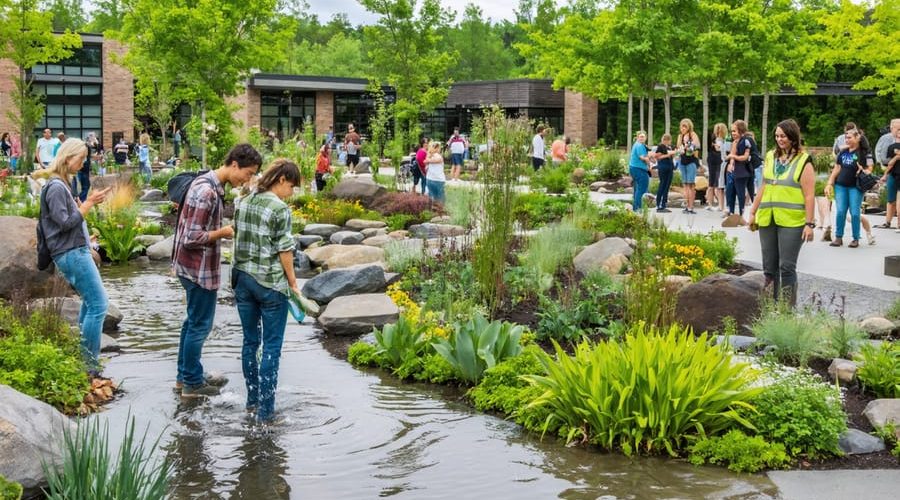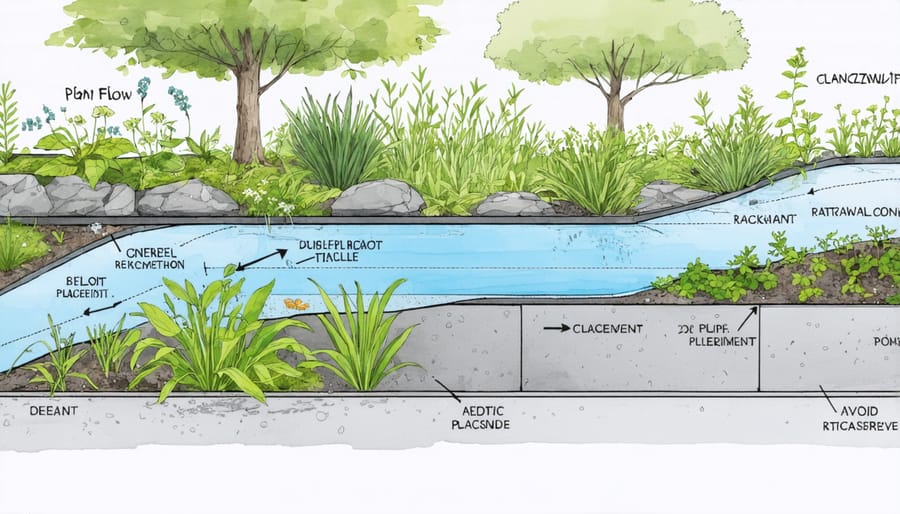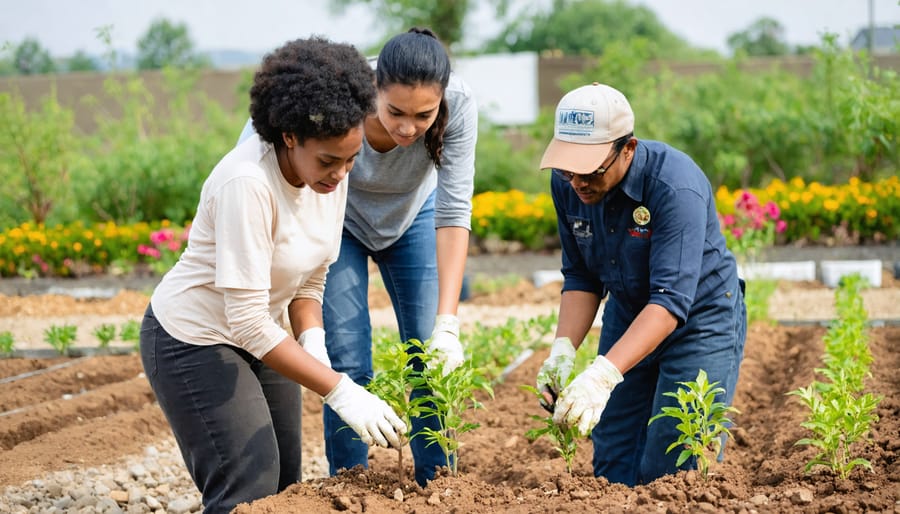
Build a Community Water Garden That Saves Money and Resources
Transform your garden into a water-wise oasis while building meaningful community connections through smart conservation techniques. Water conservation gardening isn’t just about reducing water bills—it’s a powerful approach to creating sustainable, resilient landscapes that thrive in any climate while bringing people together.
By implementing proven strategies like rainwater harvesting, drought-resistant plant selection, and efficient irrigation systems, gardens can reduce water consumption by up to 50% while maintaining their beauty and productivity. Whether you’re working with a neighborhood group, school community, or local environmental organization, these water-saving techniques create opportunities for shared learning and collaborative success.
The rise of water conservation gardening reflects a growing awareness of our environmental impact and the need for community-based solutions. As water resources become increasingly precious, gardeners worldwide are discovering that working together to implement water-wise practices not only preserves this vital resource but also strengthens community bonds and creates lasting environmental change.
Join the movement of forward-thinking gardeners who are proving that beautiful, productive gardens can flourish while using less water. Through shared knowledge, collective effort, and innovative conservation methods, we can create sustainable gardens that inspire and educate future generations.
Planning Your Community Water Conservation Garden
Gathering Your Team
Building a successful water conservation garden becomes so much more manageable and enjoyable when you have the right team by your side. Start by reaching out to your local gardening clubs and community centers – these are fantastic places to find like-minded individuals who share your passion for sustainable gardening.
Social media platforms can be incredibly useful too. Join local gardening groups on Facebook or NextDoor to connect with neighbors who might be interested in joining your project. Don’t forget to check with local environmental organizations, as they often have members eager to participate in eco-friendly initiatives.
When assembling your team, look for people with diverse skills. You’ll want someone with basic gardening knowledge, perhaps another person who’s good with project planning, and maybe someone who understands irrigation systems. Even complete beginners can contribute enthusiasm and helping hands!
Consider hosting a casual meet-and-greet at a local coffee shop or community center. This gives potential team members a chance to learn about the project and share their ideas. Remember to keep the group size manageable – typically 5-8 people works well for most community garden projects.
Selecting the Perfect Location
Choosing the right location for your water conservation garden is crucial for its success and long-term sustainability. Start by identifying a spot that receives adequate sunlight – most water-wise plants need at least 6 hours of direct sunlight daily. However, you’ll also want to include some partially shaded areas to reduce water evaporation and provide variety in your plant selection.
Consider the natural slope and drainage patterns of your potential garden site. A gentle slope (about 2-3%) is ideal as it allows excess water to flow naturally while preventing erosion. Avoid areas where water tends to pool, as this could lead to waterlogging and plant disease.
Soil quality plays a vital role too. Test your soil’s drainage by digging a hole about 12 inches deep, filling it with water, and monitoring how quickly it drains. Good drainage is essential for healthy root development and efficient water use. If your soil drains too quickly or too slowly, you may need to amend it with organic matter.
Think about accessibility – both for maintenance and community engagement. The garden should be easily reachable for regular care and educational activities. Consider proximity to water sources, as hauling water long distances can be impractical and energy-intensive.
Wind exposure is another important factor. Strong winds can increase water evaporation and stress plants. If your chosen site is windy, plan to incorporate windbreaks like shrubs or decorative screens. Also, keep in mind the location of underground utilities and ensure proper clearance from buildings and other structures.
Finally, check local regulations regarding water features and community gardens. Some areas have specific requirements for water conservation projects that might influence your site selection.

Water-Smart Design Features
Rain Gardens and Bioswales
Rain gardens and bioswales are nature’s way of managing water runoff while creating beautiful, sustainable landscape features. These clever systems work by collecting rainwater and allowing it to slowly filter through specially selected plants and soil layers, reducing water waste and preventing flooding.
Think of a rain garden as a shallow depression in your yard that captures water from your roof, driveway, or other hard surfaces. When designed correctly, these gardens can absorb 30% more water than a typical lawn. For expert water garden advice, consider starting with moisture-loving native plants that can handle both wet and dry conditions.
Bioswales take this concept further by creating longer, channel-like features that direct water flow while filtering out pollutants. They’re perfect for sloped areas and can transform troublesome drainage spots into eye-catching landscape elements.
To create your own rain garden, start by identifying where water naturally collects in your yard. The ideal location is at least 10 feet from your house’s foundation. Dig a shallow basin, typically 4-8 inches deep, and add layers of well-draining soil mixed with compost. Choose plants that thrive in your local climate – think rushes, sedges, and native flowering perennials.
Both systems require minimal maintenance once established. Regular mulching helps retain moisture and prevent weeds, while occasional pruning keeps plants healthy and attractive. These natural water features not only conserve water but also provide habitat for beneficial insects and birds, making them wonderful additions to any eco-friendly garden.

Efficient Irrigation Systems
Water-wise gardening starts with implementing efficient irrigation techniques that make every drop count. For community gardens, choosing the right irrigation system can dramatically reduce water waste while keeping plants healthy and thriving.
Drip irrigation systems are perfect for community gardens, delivering water directly to plant roots through small holes in tubes or pipes. This method prevents water loss through evaporation and ensures each plant gets exactly what it needs. Install drip lines about 2-3 inches below the soil surface for optimal results.
Smart controllers and timers take the guesswork out of watering schedules. These devices can be programmed to water during early morning or evening hours when evaporation rates are lowest. Many modern systems even connect to local weather data, automatically adjusting watering times based on rainfall and temperature.
Soaker hoses offer another excellent solution for group gardens. These porous hoses slowly release water along their entire length, perfect for rows of vegetables or flower beds. They’re affordable, easy to install, and can be moved as needed throughout the growing season.
Consider dividing your garden into hydrozones – grouping plants with similar water needs together. This practice allows for more precise watering and prevents both over- and under-watering. Native plants typically need less water than exotic species, so include them in your garden design.
Regular maintenance is crucial. Check for leaks, clean filters, and adjust sprinkler heads monthly. Encourage all garden members to learn basic system maintenance – it’s a great way to build community while ensuring the garden’s long-term success.
Plant Selection and Layout
Native and Drought-Resistant Species
Choosing native and drought-resistant plants is one of the smartest moves you can make for a water-wise garden. These hardy plants have evolved to thrive in your local climate, requiring minimal additional water once established. For sunny areas, consider plants like lavender, sage, and rosemary, which not only conserve water but also provide wonderful fragrance and culinary uses.
Desert-adapted plants like succulents and cacti are excellent choices, storing water in their leaves and stems for long periods. Native grasses like blue fescue and buffalo grass make excellent lawn alternatives, requiring far less water than traditional turf grass while still providing that lovely green carpet effect.
For flowering options that won’t drain your water resources, try black-eyed susans, coneflowers, and yarrow. These beauties attract pollinators while staying resilient during dry spells. In shaded areas, plants like coral bells and native ferns can create lush displays without demanding frequent watering.
When planning your garden, group plants with similar water needs together. This practice, known as hydrozoning, helps prevent overwatering and ensures each plant gets just what it needs. Remember to add a layer of mulch around your plants – it helps retain moisture and keeps roots cool, reducing water needs even further.
Don’t forget local nurseries often carry region-specific varieties that are perfectly adapted to your area’s rainfall patterns and soil conditions. These plants will naturally require less supplemental watering while still creating a beautiful, thriving garden.
Zones and Groupings
One of the most effective ways to conserve water in your garden is to group plants according to their water needs, a practice known as hydrozoning. Start by dividing your garden into three main zones: high, moderate, and low water-use areas.
High water-use zones should be reserved for plants that need frequent watering, like vegetables and certain flowering plants. Place these closest to your water source and in areas you visit often, making it easier to monitor their needs. These zones typically include your edible garden and container plants.
Moderate water-use zones work well for established perennials, ornamental grasses, and many native plants that need occasional watering. These plants can typically thrive with weekly watering once established and should be grouped together in the middle areas of your garden.
Low water-use zones are perfect for drought-tolerant plants that rarely need supplemental watering. Think succulents, native species, and Mediterranean plants. Place these in naturally drier areas of your garden, such as slopes or sunny spots away from regular foot traffic.
Remember to consider your local climate and soil conditions when planning these zones. Group plants with similar sun exposure requirements together within each water zone. This thoughtful organization not only saves water but also makes maintenance easier and helps your plants thrive in their ideal conditions.

Maintaining Your Community Water Garden
Creating a Maintenance Schedule
Creating an effective schedule for your water conservation garden ensures its long-term success while making the workload manageable for everyone involved. Start by listing all necessary garden maintenance strategies and categorizing them by frequency: daily, weekly, monthly, and seasonal tasks.
Daily tasks might include checking irrigation systems and removing visible debris. Weekly responsibilities could involve monitoring soil moisture levels and adjusting watering schedules. Monthly duties typically encompass pruning, mulch maintenance, and checking for water-efficient equipment repairs.
Consider creating a rotating schedule where team members switch responsibilities every few weeks. This helps everyone learn different aspects of garden care while preventing burnout. Use a shared digital calendar or a physical bulletin board to track assignments and completion dates.
Make the schedule flexible enough to accommodate members’ varying availability. For instance, those with weekday commitments might take weekend shifts, while others could handle weekday morning tasks. Include backup plans for when scheduled members can’t fulfill their duties.
Don’t forget to schedule regular community meetings to discuss challenges, share successes, and adjust the maintenance plan as needed. Keep a log book where members can note observations and tips, creating a valuable resource for future reference. This collaborative approach ensures your water conservation garden thrives while building a stronger community connection.
Monitoring Water Usage
Keeping track of your garden’s water usage is essential for successful water conservation. Start by installing a water meter specifically for your garden area – this small investment will pay off by helping you identify exactly how much water you’re using and where adjustments are needed.
Create a simple water monitoring log to record daily or weekly usage. Note weather conditions, watering times, and any unusual patterns you observe. Many smart irrigation systems now come with built-in monitoring features, making this process even easier. If you’re using a traditional system, set a reminder to check your meter readings at the same time each week.
Look for signs that might indicate water waste: puddles forming after irrigation, water running off onto pathways, or areas of your garden that seem consistently soggy. These are clear indicators that adjustments are needed. Consider installing soil moisture sensors in different garden zones – they’ll help you understand when plants actually need water rather than following a rigid schedule.
Regular monitoring also helps detect leaks early. A sudden spike in water usage without changes to your watering routine could signal a problem. Walk your garden regularly to check for leaking pipes, broken sprinkler heads, or damaged irrigation lines. Remember, even small leaks can waste hundreds of gallons over time.
By tracking your water usage consistently, you’ll develop a better understanding of your garden’s actual needs and can make informed decisions about irrigation schedules and methods.
Water conservation gardening isn’t just about saving resources – it’s about building a more sustainable and connected community. By starting a community water conservation garden, you’ll create a space where neighbors can learn, grow, and make a positive environmental impact together. The benefits extend far beyond water savings, including stronger community bonds, shared knowledge, and a beautiful green space everyone can enjoy. Whether you start small with a few raised beds or dream big with a neighborhood-wide project, every drop saved matters. Take that first step today by reaching out to your neighbors, local gardening groups, or community center. Together, we can create beautiful, water-wise gardens that inspire others and help protect our precious water resources for future generations. Remember, even the smallest water-saving efforts can create rippling effects of positive change throughout your community.
